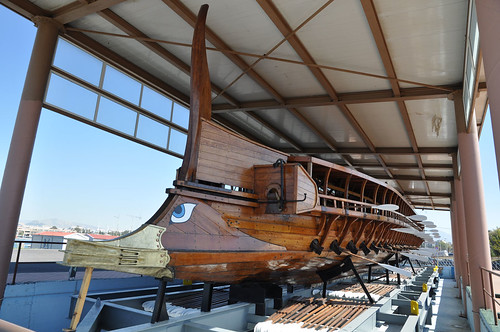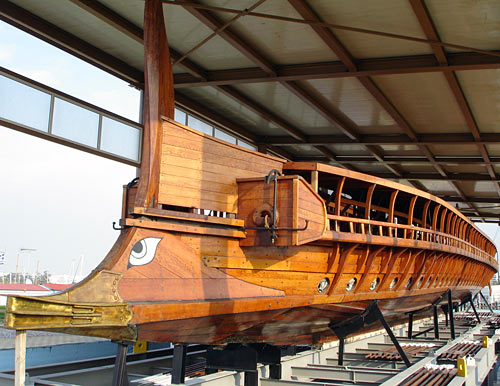The trireme was the mainstay of ancient European navies.
The only weapons a trireme had were a ram on the front, and a collection of marines standing around waiting to board other vessels. So the ship had to be fast and manoeuvrable enough to aim at, catch up with, and with any luck ram, enemy vessels. The result of these requirements was a narrow, light and fast ship, powered by simple square sails when possible, and by well over a hundred oarsmen (employed, not enslaved) the rest of the time.
A trireme's top speed was only about nine knots (more than ten miles per hour, almost 17 km/h). Maybe a little more with adrenaline-powered rowers (you did not want to be on the losing side of an ancient naval battle...) and a literal following wind. But that was not a bad speed at all for a warship through the whole of the Age of Sail. Small sail-powered warships and armed merchantmen could average better than ten knots when the winds were good - the best of the late-Sail-Age clipper ships were renowned for being able to sustain more than twenty knots. But ten knots was the ceiling for most warships, definitely including the mighty First-Rate ships of the line epitomised by HMS Victory. Those ships could have sailed like lightning when the wind was strong if their sails, ropes and masts were indestructible, but they weren't, so one way or another, ten knots was the screaming maximum.
So if you took away Victory's gunpowder, then no matter how the wind was blowing, she wouldn't be able to catch a trireme except via a sort of persistence hunting, waiting for the oarsmen to run out of energy.
Since triremes were built more than two thousand years before Victory, I think that's not a bad achievement.
(It's neither here nor there, but I actually much prefer Warrior to Victory. Warrior has always struck me as being the Enterprise-C of real-world warships.)
There were larger galleys than triremes, with even more ranks of rowers. At the top end of the ancient-warship size chart are various legendary vessels that may or may not ever actually have existed, but "quadremes" and "quinqueremes" definitely did exist, in considerable numbers.
The bigger they were, though, the slower they were. Without faster vessels like triremes (which sometimes towed or pushed larger, slower galleys), the giant galleys could only force combat upon similarly slow vessels.
Exactly how triremes worked and what they could do, though, is uncertain. None survive, and neither do any operating manuals.

(Image source: Flickr user Pensive glance)
So some experimental archaeologists made a new one, the Olympias.

(Image source: Flickr user John S Y Lee)
The Olympias has a full complement of 170 oars-people; for its sea-trials in 1990 it was rowed by a mix of male and female volunteers:
(The Olympias also carried the Olympic flame across Piraeus harbour for the 2004 Athens Olympics, and might have done something similar for the London Olympics, but those plans were scrapped. It also apparently featured prominently in an episode of Inspector Morse, of all things.)
People have, of course, made remote-controlled model galleys...
...and related vessels...
...some rather impressive...
...and these ones...
...even manage two ranks of oars:
I would pay ten dollars to see one of those ram and sink an R/C Warship Combat ship.
(This would be easy, because the Warship Combat ships are deliberately made with thin balsa over much of the hull, so they can sink each other with little, or not-so-little, CO2 cannons; a normal R/C boat is essentially invulnerable to these weapons. It would also be fun to see an R/C galley wound up to maximum possible speed, zillions of oars flailing away madly at the water.)
